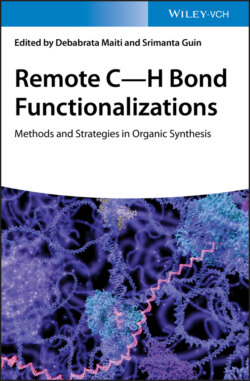Читать книгу Remote C-H Bond Functionalizations - Группа авторов - Страница 2
Table of Contents
Оглавление1 Cover
2 Title Page
3 Copyright
4 1 Introduction
5 2 Transition Metal‐Catalyzed Remote meta‐C–H Functionalization of Arenes Assisted by meta‐Directing Templates 2.1 Introduction 2.2 Template‐Assisted meta‐C–H Functionalization 2.3 Mechanistic Considerations 2.4 Conclusion References
6 3 C–H Functionalization of Arenes Under Palladium/Norbornene Catalysis 3.1 Introduction 3.2 Pd(0)‐Catalyzed C–H Functionalization of Aryl (Pseudo)Halides 3.3 Pd(II)‐Catalyzed C–H Functionalization of Arenes 3.4 Conclusions and Outlook Acknowledgments References
7 4 Directing Group Assisted meta‐C–H Functionalization of Arenes Aided by Norbornene as Transient Mediator 4.1 Introduction 4.2 meta‐C–H Alkylation of Arenes 4.3 meta‐C–H Arylation of Arenes 4.4 meta‐C–H Chlorination of Arenes 4.5 meta‐C–H Amination of Arenes 4.6 meta‐C–H Alkynylation of Arenes 4.7 Enantioselective meta‐C–H Functionalization 4.8 Conclusion References
8 5 Ruthenium‐Catalyzed Remote C–H Functionalizations 5.1 Introduction 5.2 meta‐C–H Functionalizations 5.3 para‐C–H Functionalizations 5.4 meta‐/ortho‐C–H Difunctionalizations 5.5 Conclusions Acknowledgments References
9 6 Harnessing Non‐covalent Interactions for Distal C(sp2)–H Functionalization of Arenes 6.1 Introduction 6.2 Non‐covalent Interactions in Metal Catalyzed CH Bond Functionalization 6.3 Overview of Iridium‐Catalyzed Borylation 6.4 Non‐covalent Interactions in Ir‐Catalyzed Borylation 6.5 meta‐Selective Borylation using Non‐covalent Interactions 6.6 para‐Selective Borylation using Non‐covalent Interactions 6.7 Conclusions References
10 7 The Non‐directed Distal C(sp2)–H Functionalization of Arenes 7.1 Introduction 7.2 C–Het Formation 7.3 CC Bond Forming Reactions 7.4 Outlook References Note
11 8 Transition Metal Catalyzed Distal para‐Selective C–H Functionalization 8.1 Introduction 8.2 Template Assisted para‐Selective C–H Functionalization 8.3 Steric Controlled and Lewis Acid‐Transition Metal Cooperative Catalysis 8.4 Non‐covalent Interaction Induced para‐C–H Functionalization 8.5 Conclusion and the Prospect Acknowledgments References
12 9 Regioselective C–H Functionalization of Heteroaromatics at Unusual Positions 9.1 Introduction 9.2 Indole 9.3 (Benzo)Thiophene 9.4 Pyrrole 9.5 Pyridine 9.6 Miscellaneous Heteroarenes 9.7 Conclusion References
13 10 Directing Group Assisted Distal C(sp3)–H Functionalization of Aliphatic Substrates 10.1 Introduction 10.2 γ‐C(sp3)–H Functionalization of Aliphatic Acids 10.3 δ‐/ɛ‐C(sp3)H Bond Functionalization of Aliphatic Amines 10.4 γ‐C(sp3)H Bond Functionalization of Aliphatic Ketones or Aldehydes 10.5 γ‐/δ‐C(sp3)H Bond Functionalization of Aliphatic Alcohols 10.6 Conclusions and Outlook References
14 11 Radically Initiated Distal C(sp3)–H Functionalization 11.1 Introduction 11.2 Distal C(sp3)–H Functionalization Promoted by Carbon‐Centered Radicals 11.3 Distal C(sp3)–H Functionalization Promoted by Nitrogen‐Centered Radicals 11.4 Oxygen‐Centered Radicals Initiate Distal C(sp3)–H Functionalization 11.5 Summary and Outlook References
15 12 Non‐Directed Functionalization of Distal C(sp3)H Bonds 12.1 Introduction 12.2 Reactions Occurring Without Formation of Metal–Carbon Bonds 12.3 Reactions Occurring via Formation of Metal–Carbon Bonds 12.4 Altering Innate Reactivity by Polarity Reversal Strategies Acknowledgments References
16 13 Remote Oxidation of Aliphatic CH Bonds with Biologically Inspired Catalysts 13.1 Introduction 13.2 Innate Substrate Based Aspects Governing Site Selectivity in C–H Oxidations 13.3 Remote Oxidations by Reversal of Polarity 13.4 Remote Oxidations Guided by Supramolecular Recognition 13.5 Selective Aliphatic C–H Oxidation at Dicopper Complexes 13.6 Conclusions References
17 Index
18 End User License Agreement
